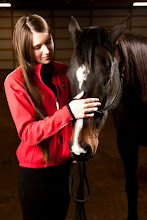Hello to all,
The past week has caught me unprepared and forgetful. The weather switched from blizzard to spring-like with my days spend outside in short sleeves. I have no excuses for an absence this early in the blog, but I have resolved to be more diligent. Monday and Tuesday became productive days on the horses. Ziggy, our problem child, saw the vet, who ruled out kissing vertebrae as the cause of his laying down while being ridden. He awaits an appointment with a chiropractor and acupuncturist next week. These last two days, I worked him on the ground teaching him to move in a forward walk, circle, change directions, and walk-trot transitions. He is nervous in the arena but quiets down each day.
Cody is a larger problem. He walks as though trudging through sand after hours of work. Riding outside and working on short periods of walk-stop transitions are helping, but he has a long road ahead of him. Any ideas for loosening up his feet would be appreciated very much. He protests anything but the softest cue by growing even slower. Transitions help, but he's still too slow.
Maggie worked on relaxing. Never has there been a tighter mare! She clamps every muscles from her jaw to her tail. Switching from shoulder-in for a step to traver for a step seems to be the trick for her. I can't imagine that will be pretty at a canter.
Dancer is the same as always. He is stuck to routine like he suffers from OCD. His little rituals (backing up two steps before accepting the bit, moving a step to the right when being saddled, circling his pen once before eating his hay) are the best indication of his mood. Next week we leave for the National Western Stock Show, so, until after then, I am sticking with the same training he's used to.
As promised last week, this post will start a summary of the most important trainers in French equitation. We'll start with the earliest and continue tomorrow. Anyone in the dressage industry can probably name Antoine de Pluvinel (1552-1620). Pluvinel's most important innovations to horsemanship were humane methods, the use of two pillars, and shoulder-in. He writes of these in his L'Instruction du Roy and Le Maneige Royal, both written as a dialogue between he and his student, King Louis XIII.
At ten years old, Pluvinel began studying horsemanship in Italy with Pignatelli, who beat the horse into obedience. In his twenties, he returned to France to ride with Sourdis before being ecuyer to various aristocrats and royalty. It was in France that he developed his Academie d'Equitation that taught French nobility how to perform noble arts (riding, fencing, dance, etc.). Because the basis of nobility was beauty, Pluvinel believed a horse trained with kindness would perform more beautifully.
When learning of the trainers, it's important to understand their society because that tells us why they altered training methods. France in the 16th century had a definite class system. The nobility held the top of the class system and privilege marked the difference between them and everyone else. They did not have to work to live, nor did they have to pay taxes. They used their wealth to buy honor and prestige. Fencing, dancing, fine dress, attending spectacles, likening themselves to antiquity, and riding were symbols of privilege. Riding was unique because it was used across all the arts: painting, sculpture, literature, spectacles. Lavish spectacles (quadrilles) were performed for entertainment and to display one's equestrian skill. Riding also showed that a nobleman was from old lines or part of the sword nobility (the nobles that fought in war). Though the cavalry was no longer very important in war due to firearms, riding symbolized military might.
Tomorrow, and I promise it will be tomorrow, we'll move into the later 16th century and 17th century with Cavendish and Gueriniere. Until then, take care and enjoy the warm weather if you're lucky enough to have it, too. KMoreaux
Wednesday, January 13, 2010
Subscribe to:
Post Comments (Atom)

No comments:
Post a Comment